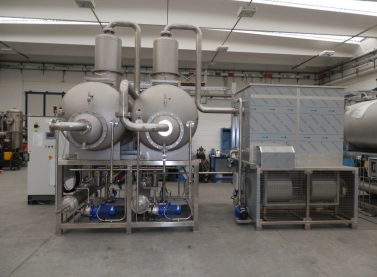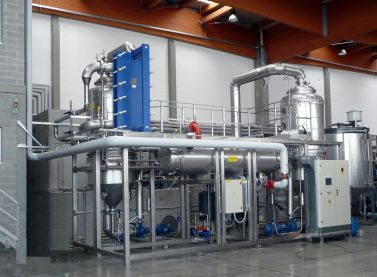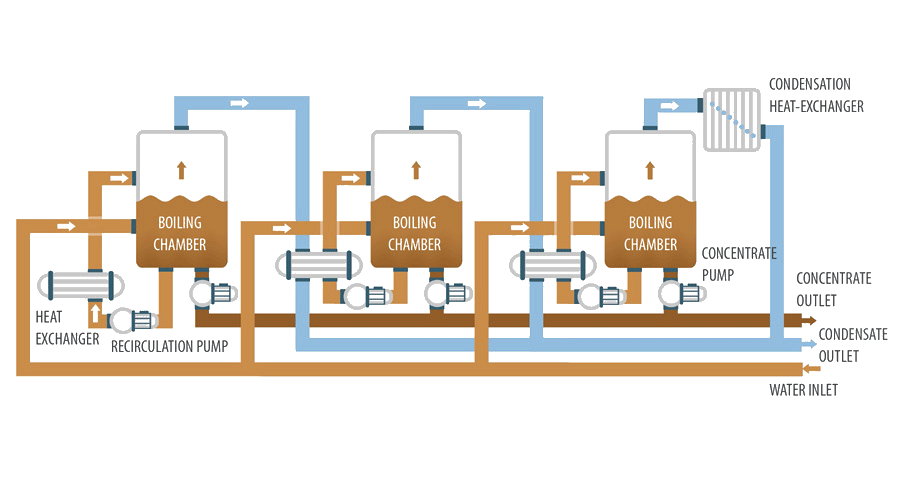Condorchem Envitech Offer
We design and manufacture multiple effect evaporators, which are the best option for the treatment of high volumes of industrial wastewater. Our multiple effect evaporators use hot water or steam from an external circuit as a source of energy, which allows residual heat flows to be utilized.
Multiple effect evaporators allow the recovery and reuse of high volumes of water, as well as the revalorization of raw materials or by-products present in the effluent, while reducing the costs associated with the management and transport of waste. It is an ideal solution for companies that intend to implement circular economy solutions in their processes.
Our multiple effect evaporators can be composed of 1 (single effect evaporator), 2 (double effect evaporator) or 3 (triple effect evaporator) effects, where the heat transferred to the evaporated effluent is completely recycled in the following stages, producing a cascade effect. Finally, the distillate is condensed by a cooling tower, with little water consumption.
Single and multiple effect evaporators
Multiple effect evaporators cover a wide range of wastewater volumes. The Envidest DPM1, Envidest DPM2 and Envidest DPM3 units, with one, two and three effects respectively, have a horizontal boiler and internal heat exchanger and are designed to handle flow rates up to 30 m3/day.
The Envidest MFE1, Envidest MFE2 and Envidest MFE3 evaporators, with one, two and three effects respectively, have a vertical boiler and forced circulation external heat exchanger designed to handle higher flows up to 180 m3/day.
Our multiple effect evaporators
 ENVIDEST DPM 1Single effect thermal vacuum evaporators
ENVIDEST DPM 1Single effect thermal vacuum evaporators ENVIDEST DPM 2Double effect thermal vacuum evaporators
ENVIDEST DPM 2Double effect thermal vacuum evaporators ENVIDEST DPM 3Third effect thermal vacuum evaporators
ENVIDEST DPM 3Third effect thermal vacuum evaporators ENVIDEST MFE 1Single effect thermal vacuum evaporators by forced circulation
ENVIDEST MFE 1Single effect thermal vacuum evaporators by forced circulation ENVIDEST MFE 2Double effect thermal vacuum evaporators by forced circulation
ENVIDEST MFE 2Double effect thermal vacuum evaporators by forced circulation ENVIDEST MFE 3Triple effect thermal vacuum evaporators by forced circulation
ENVIDEST MFE 3Triple effect thermal vacuum evaporators by forced circulationAdvantages
- Minimization of the waste volume to be managed
- Significant reduction in waste management costs
- Promoting the re-use of a significant part of the liquid effluents
- Possibility of implementation of a zero discharge system
- Fulfillment of the current regulations on discharge of effluents
- Reduction of the need to store large volumes of waste
- Reduction in greenhouse gas emissions when transporting the waste
- Reduction in the consumption of mains water by re-using treated water
- Absence of reagents (except for antifoam in some cases)
- High energy efficiency
- Highly suitable for the treatment of high flows
- Ease of increasing the number of effects without increasing energy consumption
Applications
- Oily emulsions, coolant fluids, mould release agents
- Purging of compressors, water from washing floors
- Water from washing tanks and reactors (in the chemical, pharmaceutical, cosmetic and perfumery industries)
- Working and wash baths in galvanic processes and surface treatments
- Penetrating liquids
- Graphic arts waste (e.g. cleaning water and paint)
- Water treatment plant reject (e.g. reverse osmosis and demineralizers)
- Leachate from municipal solid waste dumps
- Digestate from biogas generation plants
- Food and beverage industry
- Pickling industry
- Energy generation
- Paper, minerals and extraction industries
Introduction to the technology
Multiple effect vacuum evaporators are best suited for the treatment of high flow rates, especially when a low-cost heat source (e.g. hot water or steam) is available.
Vacuum evaporators can treat an aqueous waste stream efficiently and simply without using reagents. They are highly effective even when conventional technologies are not viable. Using a vacuum evaporator, waste effluent is transformed into two streams: one, highly concentrated (perhaps even dry) and the other high quality water. Evaporators work under vacuum conditions to reduce the boiling temperature of the liquid effluent and lower energy consumption.
As mentioned before, a multiple effect evaporator is an equipment consisting of a set of evaporators conveniently linked to evaporate wastewater efficiently. The first effect is powered by steam from a steam generator. The steam produced in the first effect is used to heat the second evaporator, where the steam is condensed at a temperature higher than the boiling temperature of the wastewater that evaporates in it. The same process happens in every following stage.
Functioning of multiple effect evaporators
Equipment operation
A multi-effect vacuum evaporator consists of a set of interconnected evaporators where the first effect is the first evaporator, and so on. Using a multiple effect evaporator, the operation is based on the steam produced in one effect being used as the heat source for the following effect. As the temperature decreases from one effect to the next, the vacuum is increased so that the boiling point is lower and evaporation is maintained. Thus, there is a working pressure and temperature gradient in which both parameters decrease from one effect to the next.
This configuration considerably increases the energy efficiency of the process. In practice, a 3-effect evaporator consumes the same energy as a single-effect evaporator but produces 3 times more distillate. Although the investment cost is higher, the energy consumption is much lower, so multi-effect vacuum evaporators are the most suitable for the treatment of high flows. When residual waste heat is available, the multi-effect vacuum evaporators can take advantage of it and are highly competitive.
These multi-effect vacuum evaporators are designed to be extended from 1 to 2 or 3 stages, and therefore to double or triple production without increasing the energy supply.
In a multiple effect evaporator, the water is boiled in a sequence of tanks, each with a lower pressure than the previous one. Due to the boiling temperature of water, the steam that boils in one evaporator can be used to heat the next, and only the first evaporator (the one with the highest pressure) requires an external source of heat. In theory there is no limit to the number of stages that can be built, but evaporators with more than four stages are rare exceptions.
During operation, the steam generated in the first effect is used to heat the second effect, whose steam is used to heat the third effect and so on. To operate properly it is necessary that the heating steam in each effect condensates at a higher temperature than the boiling temperature in the same effect, which requires a sufficient pressure difference between the different effects for boiling to occur.
Finally, the water vapor produced in the last effect is collected in a condenser, which is also connected to a vacuum system. If the evaporators are numbered in the order that the pressure decreases, and the pressures and temperatures in each unit are, respectively, P1, P2, and P3, and T1, T2, and T3, then it is true that: P1> P2> P3 AND T1> T2> T3.


